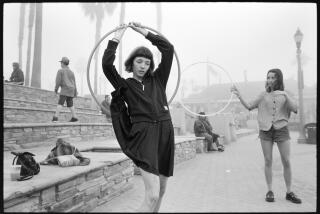From 400 Negatives, Something Pretty Positive
As a rule, the world isn’t kind to artists, typically indifferent or quick to dismiss them as childish, self-indulgent, useless.
Nonetheless, this is the group that 72-year-old Martin Elkort, during a long adulthood of family-providing and general usefulness, yearned to be a part of.
Perhaps appropriately, it was a near-calamity that led to Elkort’s acquiring such a melancholy ambition. A shy, book-loving boy from the Bronx, he contracted polio at age 15 while swimming in an algae-filled stream on a Pennsylvania farm. He narrowly escaped being consigned to an iron lung, but the disease permanently obliterated his left biceps and triceps.
As consolation, his father, a shoe salesman, and his mother, a stenographer, gave him a $60 Ciroflex camera, and before long, photography replaced polio as a consuming force in his life.
While attending The Cooper Union for the Advancement of Science and Art, Elkort worked for a commercial photographer, but found mercantile picture-making not to his liking. What stirred him was wandering the streets of New York City and capturing the images of ordinary people--children, shopkeepers, needle-trade workers--as they moved through the landscapes of their lives. He developed a sneaky technique for catching his subjects unaware. He’d walk along a sidewalk peering down through the viewfinder of his reflex camera, as though navigating by it, never looking up at his prey, which usually didn’t react to what he was up to till he’d bagged them.
He joined the Photo League, composed of street photographers and aesthetic revolutionists who defied the then-prevalent opinion that photography could not be art.
Although very young, Elkort produced good work. He had pictures published in two national photography magazines. Then, in 1955, Edward Steichen, curator of photography at New York’s Museum of Modern Art, bought three of his pictures for MOMA’s collection. Elkort received $5 for each and walked on air for two months.
Alas, the gravity-observant thought of making a family-sized living (he was now married and hoping for children) soon returned him to earth. On the heels of his private triumph came the time for him to give up art.
So he placed his 400-odd black-and-white negatives in glassine envelopes, put them to sleep in a green cardboard box and roused himself for a more quotidian life. He and his wife, Edith, had three children. He worked publicity for the New Mexico state tourist office, then promoted travel to Israel in Los Angeles, then managed an amusement park in Fairbanks, Alaska. He and Edith eventually opened a travel agency in Beverly Hills.
Almost half a century passed.
Two years ago, Elkort, retired, received a digital camera as a gift from his children. The camera made something smoldering inside him leap into flame. He woke his old negatives from their long slumber and began scanning them into his computer and making prints. The pictures snapped him back to the streets of a New York, to faces and casual social rituals, now long disappeared.
He pondered his 1951 photograph of a 5-year-old girl squatting on the boardwalk at Coney Island while a black cat rubbed against her back. It was one of those Steichen had bought for MOMA. “Where are you now?” he asked the little girl in the photo. “What kind of woman did you become? Has life been good to you?”
He got up his nerve and began showing the photos around. Unlike those of many other Photo League members, Elkort’s images weren’t preoccupied with the city’s picturesque desolation, human and otherwise. They tended toward the innocent and joyful. “They’re really wonderfully composed, very thoughtful,” says San Francisco collector Adam Gendell. “He has a really great eye for capturing quiet, private moments, especially when it comes to children.”
It’s taken an unimaginably long time, but an unimaginably gratifying thing has happened. Elkort has made it into the galleries. Gendell’s Artseal Gallery is featuring new collector-quality prints of more than 30 of Elkort’s old images as part of a three-photographer show that runs through August. The John Cleary Gallery of Houston is planning an exhibition for the coming year. The Gatov Gallery at the Long Beach Jewish Community Center has mounted a one-man Elkort show, the artist’s first, through August 9.
Recently Artseal sold one of his pictures for $800.
“I’m walking on air again,” Elkort says. “All I ever wanted to be was a street photographer.”
Nowadays, he is back at it. He often takes his camera to L.A.’s garment district and plunges into the weekend crowd there “like it’s the surf at Santa Monica Beach.”
On this go-round, he knows, the time is short. “I feel privileged to have the second chance that most people never get, and I don’t want to blow it,” he says. “There’s too much at stake.”
All right, here is my definition of art: an attempt, as heroic and futile as religion, to transcend existence, ie., to defeat death.
I think artists, deep inside, sense the truth of this, and are haunted by it. That explains why it’s so hard for them to not make art, despite the world’s discouragement, to not strive, as Elkort puts it, “to leave a little scratch on the universe somewhere.”
More to Read
The biggest entertainment stories
Get our big stories about Hollywood, film, television, music, arts, culture and more right in your inbox as soon as they publish.
You may occasionally receive promotional content from the Los Angeles Times.










